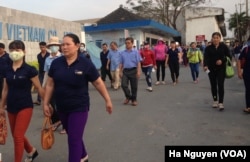In 2017, long after the Vietnam War, U.S. President Donald Trump finally made his debut in Vietnam, not in the capital city of Hanoi in the north, nor in the business hub of Ho Chi Minh City in the south, but at about the midway point, in Da Nang.
The central Vietnamese city was hosting dozens of global leaders at the time, from New Zealand’s Jacinda Ardern to South Korea's Moon Jae-in to Trump, at the Asia Pacific Economic Cooperation summit. Pulling off one of the world’s biggest conferences without a hitch gave Da Nang something to brag about.
But it also was a sign of something bigger: locals and foreigners are now looking beyond Vietnam’s biggest cities and finding potential in second-tier locales.
Da Nang is seen as a clean, well-managed city. The northern port of Hai Phong is luring trade from China. The province of Binh Duong, next to Ho Chi Minh City, is a prime spot for industrial production.
The trend suggests that as Vietnam develops, it has a chance to spread out economic gains across the country. While many countries concentrate growth in coastal urban areas, Vietnam could see a more even distribution that reduces inequality and enables sustainable growth.
“Da Nang is currently one of the emerging hotspots for foreign direct investment inflow from Singapore and Europe,” recruitment agency Navigos Group said in a news release, noting that Binh Duong had even higher demand for employees and a bigger labor pool.
The company opened a branch in Da Nang earlier this year, following a string of other businesses, from a German information technology outsourcing firm to the Australian Chamber of Commerce in Vietnam.
“The rapid increase in recruitment demand brings many challenges,” said Gaku Echizenya, the CEO of Navigos Group. “We decided to inaugurate a representative office in Da Nang to help businesses and candidates easily connect with each other.”
In the past Da Nang was known for its beaches and for seeing the first U.S. troops to deploy in the Vietnam War, in 1965. But more recently its municipal government has made it a place to do business. Its relatively clean streets and low crime rate make it attractive for Vietnamese seeking a less polluted place to escape the big cities. Da Nang ranked No. 5 in the latest Provincial Competitiveness Index, which scores cities and provinces based on business indicators like corruption and land access.
Receiving even more foreign investment than Da Nang in 2018 was Hai Phong. The city’s airport links international travelers to the UNESCO World Heritage site at Ha Long Bay. But beyond that it has been a key shipping hub, even more so as investors move out of China and seek alternative trading partners like Vietnam.
“Hai Phong has all the necessary ingredients to develop into a true global port city,” along the lines of Amsterdam and London, said Stephen Wyatt, country head of the real estate firm JLL Vietnam.
He suggested the city focus on improving areas that could increase logistics efficiency, from traffic management, to customs procedures, to use of new technology.
Other locations are getting more attention, too. Another domestic carrier, Bamboo Airlines, launched in January, and promises to bring more people and business to Quy Nhon, where the company is based. The town also operates a large container port and is becoming a more popular tourist destination.
Elsewhere, Vietnam seems full of factory-filled zones where investor demand is taking up most of the supply of real estate, from Dong Nai and Long An in the south to Bac Ninh and Hai Duong in the north.
It has not all been smooth sailing. Da Nang’s fast rise has come with criticism that its late technocratic leader Nguyen Ba Thanh ruled with an iron fist. And despite its generally well regulated reputation the city is now stuck in a business-government corruption scandal. But for better or worse, this and other of Vietnam’s second-tier cities are getting more of the spotlight than ever.









